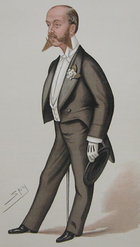Alfred de Rothschild
| Alfred de Rothschild | |
|---|---|

Alfred de Rothschild, by Leslie Ward, 1884
|
|
| Born | 20 July 1842 England |
| Died | 31 January 1918 England |
| Resting place | Willesden Jewish Cemetery |
| Residence | Seamore Place, London, England Halton House |
| Education | King's College London, Trinity College, Cambridge |
| Occupation | Banker, consul, art collector, philanthropist |
| Board member of | N M Rothschild & Sons, Bank of England, National Gallery, Wallace Collection |
| Partner(s) | Marie Boyer |
| Children | Almina |
| Parent(s) | Lionel de Rothschild & Charlotte von Rothschild |
| Awards |
Royal Victorian Order (1902) Legion of Honour Order of the Crown (Prussia) Order of Franz Joseph |
Alfred Charles Freiherr de Rothschild CVO (20 July 1842 – 31 January 1918) was the second son of Lionel de Rothschild and Baroness Charlotte von Rothschild of the prominent Rothschild family.
As a young man, Alfred attended King's College School, and subsequently Trinity College, Cambridge, England, where he would study Mathematics for two terms. It was at Trinity College that Alfred formed a lasting friendship with the Prince of Wales, later King Edward VII. Alfred left Cambridge University without a degree.
At the age of 21 Alfred took up employment at the N M Rothschild Bank at New Court in London. It was there that he learnt the business of banking from his father and made valuable contacts in European banking circles.
In 1868, at the age of 26, Alfred became a director of the Bank of England, a post he held for 20 years, until 1889. In 1892 he was one of those who represented the British Government at the International Monetary Conference in Brussels.
His career at the Bank of England was described in The Rothschilds: A Family of Fortune, by Virginia Cowles (London: Futura Publications 1975) page 159:
Alfred was not only a partner at New Court but a Director of the Bank of England, an appointment he had been given in 1868 because the Governor felt it would not be a bad thing to keep in close touch with the Rothschilds. The relationship came to an abrupt end of 1889, however, over a slightly unorthodox situation. Alfred had paid a very high price for a French eighteenth-century painting after being assured by the dealer that he, too, had been forced to pay an excessive sum for it and was making only a marginal profit. A day or two later Alfred discovered that the dealer had an account with the Bank of England. He could not resist taking a peep to see what, in fact, the man had given for the painting. He was outraged when he discovered that he had been charged a price 'out of all proportion to decency!' He spread the story about London and, not surprisingly, got the sack from Threadneedle Street.
...
Wikipedia
